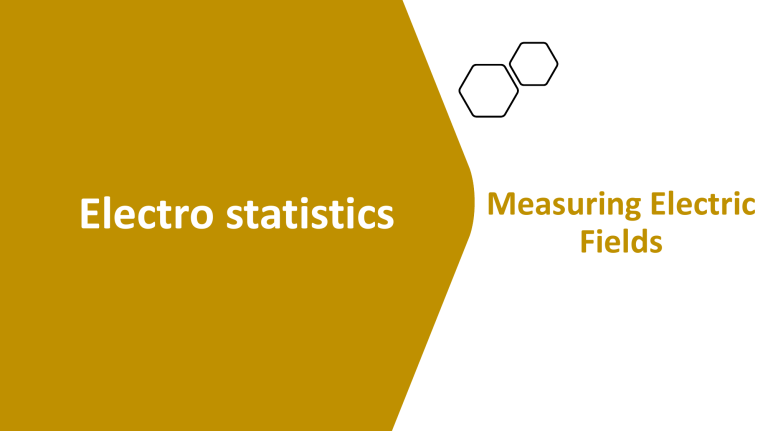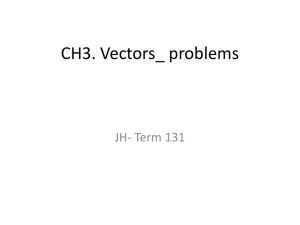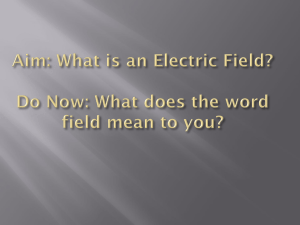
Electro statistics Measuring Electric Fields Learning Objectives • Define the electric field vector at a point in space as the quotient of the electrostatic force vector acting on a positive test charge at this point divided by the test charge • Electric field Keywords • Electric field lines • Field vectors • Coulomb’s law Question Question: Two spheres P and Q have an even charge distribution of 10 x 10 -6 C and 20 x 10 6 C and their centers are separated by 12 cm. What is the size and direction the electrostatic force acting on the particles? Charges are both positive so the direction is that the forces will be repelling each other Example Question Question: Two spheres P and Q have an even charge distribution of 10 x 10 -6 C and 20 x 10 6 C and their centers are separated by 12 cm. What is the size and direction the electrostatic force acting on the particles? Answer: qP = +10 x 10-6 C qq = +20 x 10-6 C K = 9 x 109 Nm2C−2 r = 12 cm / 100 = 0.12 m = 12 x 10-2 m Fe = ? Charges are both positive so the direction is that the forces will be repelling each other Electric Field Charged particles exert a force on one another. An electric field is a measurable effect generated by any charged object. https://www.youtube.com/watch?v=S8TT1xXfJuA To understand electric field, let’s understand the working of plasma Sphere! Let’s understand Electric Field Electric Field Strength Electric Field strength (E) relates force (F) on a positive test charge with the strength of the charge (𝑞 / ) by : The magnitude of the electric field is measured in Newtons per Coulomb, N/C. We can use coulomb’s law to find F Coulomb’s Law Coulombs law allows us to work out the force of attraction or repulsion between two point-charges. 𝑭= • • • • 𝐹 is the force (N) 𝑄 is the charge (C) 𝑟 is the separation between the charges (m) 𝜖0 is the permittivity of free space 𝑸𝟏 𝑸𝟐 𝟒𝝅𝝐𝟎 𝒓𝟐 F = k 𝑸𝟏 𝑸𝟐 𝒓𝟐 Field Vectors Electric fields can be modelled using arrows to represent the field vectors at various locations. The length of the arrow represents the field strength and the direction of the arrow represents the field direction. Direction of the force on a negative and positive charge. Remember positive charges are red, negative charges are blue Field Vectors Field Vectors • The magnitude of the electric field vector is calculated as the force per charge on any given test charge located within the electric field. • Since electric field is a vector, the usual operations that apply to vectors can be applied to electric field. That is, they can be added in head-to-tail fashion to determine the resultant or net electric field vector at each location. This is shown on the next slide Review Questions A positive test charge of 5.0 × 10−6 C is in an electric field that exerts a force of 2.0 × 10−4 N on it. What is the magnitude of the electric field at the location of the test charge? A negative charge of 2.0 × 10−8 C experiences a force of 0.060 N to the right in an electric field. What are the field’s magnitude and direction at that location? A positive charge of 3.0 × 10−7 C is in a field of 27 N/C directed toward the south. What is the force acting on the charge? Review Questions A positive test charge of 5.0 × 10−6 C is in an electric field that exerts a force of 2.0 × 10−4 N on it. What is the magnitude of the electric field at the location of the test charge? Using E = F/q = we get 2.0 × 10−4 / 5.0 × 10−6 = 40 N/C A negative charge of 2.0 × 10−8 C experiences a force of 0.060 N to the right in an electric field. What are the field’s magnitude and direction at that location? Using E = F/q we get 0.06 / 2.0 × 10−8 = 3 x 106 Left A positive charge of 3.0 × 10−7 C is in a field of 27 N/C directed toward the south. What is the force acting on the charge? Using F = Q x E we get 3.0 × 10−7 x 27 = 8.1 x 10−6 N Review Questions What is the magnitude of the electric field at a position that is 1.2 m from a 4.2 x 10−6 C point charge? (Use 9 x 109 𝑁𝑚2 /𝐶 2 for k) What is the electric field at a position that is 1.6 m east of a point charge of +7.2 × 10−6 C? Review Questions What is the magnitude of the electric field at a position that is 1.2 m from a 4.2 x 10−6 C point charge? (Use 9 x 109 𝑁𝑚2 /𝐶 2 for k) Using E = kq/𝑟 2 we get 9 x 109 x 4.2 x 10−6 / 1.22 = 26250 N/C What is the electric field at a position that is 1.6 m east of a point charge of +7.2 × 10−6 C? Using E = kq/𝑟 2 we get 9 x 109 x 7.2 x 10−6 / 1.62 = 25313 N/C East Electric Field Lines Field lines indicate the direction of the force due to the electric field on a positive test charge. Spacing between lines indicates the electric field’s strength. Note: 1. Field lines never intersect each other. 2. The field lines are perpendicular to the charge 3. The magnitude of charge and number of field lines are proportional to each other 4. The start point is at the positive charge and end is at the negative charge Electric Field Lines Electric Field Lines Electric Field Lines Van De Graaff Generators Van De Graaff Generators Working Plenary LMS Quiz Electric Field





